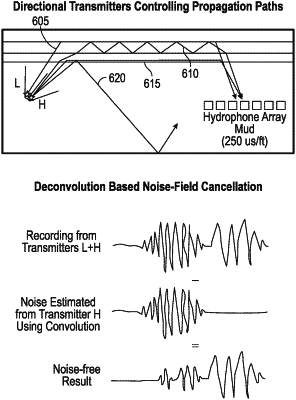| CPC G01V 1/50 (2013.01) [E21B 47/005 (2020.05); E21B 49/00 (2013.01); G01V 1/46 (2013.01); G01V 1/52 (2013.01); G01V 2210/1299 (2013.01); G01V 2210/1425 (2013.01); G01V 2210/1429 (2013.01); G01V 2210/32 (2013.01)] | 20 Claims |

|
1. A method of determining acoustic velocity behind casing or tubing in a subterranean wellbore, the method comprising:
obtaining, using an acoustic logging tool at a wellbore depth corresponding to a target subterranean formation zone, a plurality of waveform data sets, the plurality of waveform data sets comprises a first waveform data set corresponding to a first propagation path regime and a second waveform data set corresponding to a second propagation path regime;
obtaining, using the acoustic logging tool, a total wavefield across a receiver array of the acoustic logging tool at the wellbore depth;
determining a first Green's function based on the first waveform data set and a second Green's function based on the second waveform data set, the first Green's function representing the first propagation path regime and the second Green's function representing the second propagation path regime;
determining a noise wavefield by convolving the first Green's function, the second Green's function, a known transmitted pressure signal corresponding to the first waveform data set and a known transmitted pressure signal corresponding to the second waveform data set; and
generating a reduced-noise wavefield by subtracting the noise wavefield from the total wavefield.
|